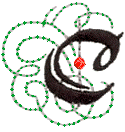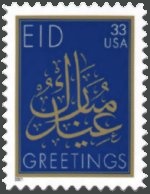 calligraphy.- Careful hand-lettering,
handwriting, or the decorative
art of lettering in an ornamental
style using brushes or pens. Or the lettering that is produced
in this way.
calligraphy.- Careful hand-lettering,
handwriting, or the decorative
art of lettering in an ornamental
style using brushes or pens. Or the lettering that is produced
in this way.
There are many kinds of calligraphy. In some cultures, calligraphy is more important as an art form than in others. Its importance is particularly great in China, Japan, and in Arabia (see Islamic art).
In Japan, shodo is "the way of calligraphy," principles through which to be in tune with the art form -- a sort of moving meditation, enhancing concentration, will-power, and composure. Gyosho is calligraphy in a semi-cursive style, and hentaigana or man'yogana is an antiquated calligraphy script that makes use of Chinese characters (kanji) utilized phonetically. A kakejuku is a hanging scroll used for mounting pieces of calligraphy. Kasure are calligraphic dry brush strokes. Kihitsu is the beginning of a brush stroke. Nenpo is a technique of producing a brushstroke that is literally the "twisting method." Nijimi are the wet, "bleeding" brushstrokes. In no-tan the caligrapher alternates the use of light and dark inks.
(pr. kuh-lig'ruh-fee)
Examples of calligraphy:

Attributed to Emperor Shomu (Japan), Nara Period, 8th century,
Kengu-kyo Sutra, a Buddhist scripture
also known as "Ojomu", brushed
ink calligraphy on paper,
27.5 x 696.9 cm, Tokyo National Museum. Japanese authorities
have designated this a "National Treasure." See Buddhist art.
Northeastern Iran or Transoxiana,
Bowl with epigraphic and vegetal decoration, 10th century, earthenware with white slip covering and decoration in pigments under a transparent glaze, 3 1/8 x 8 7/8 inches (8.1 x 22.5 cm), Los Angeles County Museum of Art. There is a black
calligraphic decoration in the outer white band. The provincial
regions of northeastern Iran and western Turkestan were major ceramic centers during the ninth and tenth centuries. Typical
of early Islamic
art is ceramic ware
featuring spare, restrained, and sophisticated
abstract decoration, as on
this bowl. Such wares characteristically show proverbs and blessings
in  Kufic script with letter forms having long, graceful descenders,
as well as zigzag edging, calligraphic bird forms,
and center medallions,
here a palmette with scrolled leaf forms. Human figures are never depicted
for religious reasons. There is a
Kufic script with letter forms having long, graceful descenders,
as well as zigzag edging, calligraphic bird forms,
and center medallions,
here a palmette with scrolled leaf forms. Human figures are never depicted
for religious reasons. There is a similar bowl in the collection of the Metropolitan
Museum of Art, NY. See Islamic
art.

Mi Fu (Chinese, 1052-1107), Poem Written in a Boat on the Wu River,
Northern Sung dynasty
(960-1127), c. 1100, handscroll, ink
on paper, 12 1/4 inches x 18 feet
3 1/4 inches (31.1 x 557 cm), Metropolitan Museum of Art, NY.
See Chinese art
and scroll.

Ahmad ibn al-Suhrawardi al-Bakri (calligrapher,
Baghdad, Iraq, Ilkhanid), Colophon page from a Qur'an manuscript,
non-illustrated detached folio,
707 AH / CE
1308, ink, colors,
and gold on
paper, height 20 3/16 inches (51.3
cm) width 14 1/2 inches (36.8 cm), Metropolitan Museum of Art,
NY. See colophon, Islamic art, and page.
Iran, late 15th-early 16th century, Page From the Diwan (collected works) of Sultan Husain Mirza, opaque watercolor, decoupage, and gold on paper, 8 7/8 x 5 3/4 inches (22.5 x 14.6 cm), Los Angeles County Museum of Art.

Attributed to Istanbul, Turkey, Ottoman,
Tughra, single work, 16th century, gouache
and gold leaf on paper, height
20 1/2 inches (52. 1 cm) width 25 3/8 inches (64.5 cm), Metropolitan
Museum of Art, NY.
![]()
Wen Zhengming (Chinese, 1470-1559), Bamboo, Orchids, Rock, and Calligraphy,
Ming dynasty, c. 1530,
handscroll; ink on paper;
signature: seals of the
artist in inscription;
seals: (upper) Wen Zhengming yin, (lower) Zheng-Zhung, Worcester
Art Museum, MA. See bamboo.
Turkey, c. 1575, Dragons Entwined On A Spray of Foliage, ink, color washes, and gold on paper, 7 1/8 x 3 3/4 inches (18.1 x 9.4 cm), Los Angeles County Museum of Art.

Attributed to Iran, Safavid, Plaque, 17th century, cut and pierced
steel, length 15 inches
(38.1 cm), Metropolitan Museum of Art, NY. See Islamic art and plaque.

American, 18th Century, Birth and Baptismal Certificate of Anne Andres,
c. 1783, National Gallery, Washington, DC. See folk art.
![]()

United States of America, designed by calligrapher
Mohamed Zakariya, Eid Mubarak, 33-cent stamp, 2000, commemorates
the two most important festivals or eids in the Islamic calendar.
Eid al-Adha marks the end of the hajj, the annual period designated
for Muslims to make their pilgrimage to Mecca. Eid al-Fitr celebrates
the end of the Ramadan fast. The Arabic phrase "Eid mubarak"
translates into English as "blessed festival," and
can be paraphrased, "May your religious holiday be blessed."
See Islamic
art and philately.
Also see bun-chin, cursive,
daho, flourish,
font, fontography,
graphic design, nib,
scriptorium, scroll, sumi-e,
text, typeface,
type, and typography.
https://inform.quest/_art
Copyright © 1996-![]()